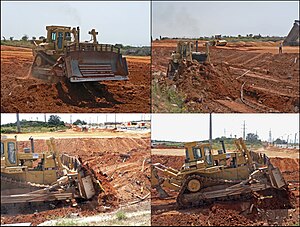
Caterpillar D10 bulldozer at work
Earthworks are engineering works created through the moving or processing of parts of the earth's surface involving quantities of soil or unformed rock. The earth may be moved to another location and formed into a desired shape for a purpose.[1] Much of earthworks involves machine excavation and fill or backfill.
Types of excavation[]
Excavation may be classified by type of material:[2]
- Topsoil excavation
- Earth excavation
- Rock excavation
- Muck excavation - this usually contains excess water and unsuitable soil
- Unclassified excavation - this is any combination of material types
Excavation may be classified by the purpose:[3]
- Stripping
- Roadway excavation
- Drainage or structure excavation
- Bridge excavation
- Channel excavation
- Footing excavation
- Borrow excavation
- Dredge excavation
Civil engineering use[]
Typical earthworks include roads, railway beds, causeways, dams, levees, canals, and berms. Other common earthworks are land grading to reconfigure the topography of a site, or to stabilize slopes.
Military use[]
In military engineering, earthworks are, more specifically, types of fortifications constructed from soil. Although soil is not very strong, it is cheap enough that huge quantities can be used, generating formidable structures. Examples of older earthwork fortifications include moats, sod walls, motte-and-bailey castles, and hill forts. Modern examples include trenches and berms.
Equipment[]
Heavy construction equipment is usually used due to the amounts of material to be moved — up to millions of cubic metres. Earthwork construction was revolutionised by the development of the (Fresno) scraper and other earth-moving machines such as the loader, production trucks, the grader, the bulldozer, the backhoe, and the dragline excavator.
Mass haul planning[]
Engineers need to concern themselves with issues of geotechnical engineering (such as soil density and strength) and with quantity estimation to ensure that soil volumes in the cuts match those of the fills, while minimizing the distance of movement. In the past, these calculations were done by hand using a slide rule and with methods such as Simpson's rule. Now they can be performed with a computer and specialized software, including optimisation on haul cost and not haul distance (as haul cost is not proportional to haul distance).
See also[]
- Cut and fill
- Earth movers, construction/engineering vehicles used for earthworks civil engineering
- Spoil tip
References[]
- ↑ Frederick S. Merritt, M. Kent Loftin, Jonathan T. Ricketts, Standard Handbook for Civil Engineers, Fourth Edition, McGraw-Hill Book Company, 1995, Page 13.1
- ↑ Frederick S. Merritt, M. Kent Loftin, Jonathan T. Ricketts, Standard Handbook for Civil Engineers, Fourth Edition, McGraw-Hill Book Company, 1995, Page 13.1
- ↑ Frederick S. Merritt, M. Kent Loftin, Jonathan T. Ricketts, Standard Handbook for Civil Engineers, Fourth Edition, McGraw-Hill Book Company, 1995, Pages 13.1, 13.2
External links[]
The original article can be found at Earthworks (engineering) and the edit history here.